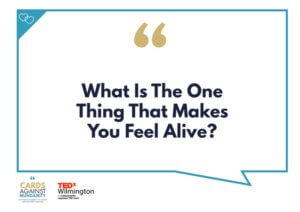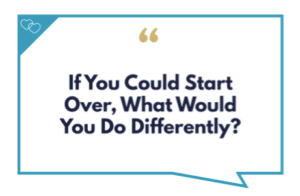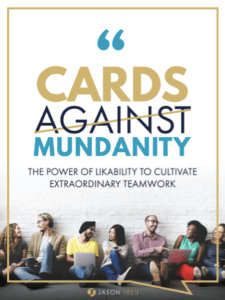Here is my 2017 TEDxWilmington speech, “How to Get CoWorkers to Like Each Other.” I discuss how to build a high performing team quickly, along with data and research I collected over the last two years. I share my free team building game, Cards Against Mundanity, that you can use to increase performance, creativity and collaboration in 45 minutes or less.
I included the transcript below.
You may not realize it, but some of you are sitting on the secret to “showing up at work.”
Now, you might say, “Hey! I show up to work every day!”
But that’s not what I mean. I mean being heard, seen, even cared for at work.
And why would that matter? It’s the #1 challenge facing companies today. Almost 70% of US workers are disengaged.
And it’s costing businesses $550 billion in lost productivity.
Listen…I know I am not telling you anything that’s not shocking here.
Whether we’re an employee or the CEO, we see the benefits that companies like Google and Zappos have created in their culture, and we want those for ourselves.
We want to be more connected with our colleagues, feel fulfilled, and have an opportunity to make a real impact.
One study found that organizations with engaged employees experienced a 19 percent increase in operating income over a 12-month period.
How can we get it?
It’s one thing to give people a nice desk, maybe some perks, but how do you get them to like one another? Even become friends?
In 1997, psychologist Arthur Aron conducted a famous experiment that gives us a hint.
Over the the course of 45 minutes, participants asked each other 36 questions.
The questions started simply: “Given the choice of anyone in the world, whom would you want as a dinner guest?”
But they soon became much more revealing: “If you were to die this evening with no opportunity to communicate with anyone, what would you most regret not having told someone? Why haven’t you told them yet?”
Aron wanted to explore whether strangers could quickly bond and form deep, close friendships by asking each other questions.
So what do you think? Could something as simple as asking questions really be the basis of lasting relationships?
Yes.
30% of the participants rated the relationships they had just created as “closer than the closest relationships in their lives.” 57% of participants got together after the study (on their own).
One of the pairs got engaged and invited everyone to the wedding!
Imagine if you could feel that way about the people you spend 8, 10, 12 hours a day with.
So why don’t we? Because we’re not showing up at work. Not really.
Let me explain.
I worked with a guy named “Jim.” Jim is a very successful CEO in a large organization. Outside of work, he’s laid-back, caring, and helps others.
Jim coaches his son’s little league team, and serves on a board of a charity organization.
But at work he’s bossy and can be a real jerk. He harshly criticizes his key leaders publicly. His leaders are constantly anxious because they never know what mood Jim will be in.
His stand-offish style alienates him from employees. When he walks around the office, people feel like they can’t approach him…even though he believes the exact opposite.
Jim’s missing out on new ideas and feedback. That’s hurting the company performance.
Here’s the thing: there isn’t one “Jim.” There are thousands of him. And her.
I’ve worked with hundreds of CEOs and executives over the last two two decades. I see it all the time: the way we connect and engage with people outside of work is completely different than how we do it inside.
So I set out to discover why.
Let’s think about what we do outside of work…when we’re “at play.”
The role of play is to connect with others. It teaches us how to communicate and collaborate.
Think about how play shows up in your life: activities, events, conversations, and more.
A huge benefit of play is that it makes us feel safe.
And that’s extremely powerful at work.
Google learned that “psychological safety” is the most critical factor behind maximizing team performance. It’s the ability of group members to connect with each other on a personal level, to feel comfortable enough to ask questions and to raise controversial ideas.
Google found that individuals on teams with higher psychological safety scores brought in more revenue, and they’re rated as effective twice as often by executives.
Why? Because it leads to better ideas by sharing and caring.
And “play” is great at that.
“Play” can bring people together and allow them to open up much quicker. And by putting the focus on an activity, rather than the conversation, it reduces self-consciousness. [introverts take note of this].
That’s what Aron was able to do. By setting up a “game” of questions, he helped build lifelong connections between complete strangers.
But remember these weren’t just any conversations — they were vulnerable self-disclosures.
But before we can ever get those kinds of conversations at work, and the engagement we want, we have to “show up” at work. But that’s not happening.
We dismiss vulnerability in the workplace, saving it for our loved ones.
Think about it…
Have you ever sat down at work with someone and shared a difficult personal struggle?
If you have, great, but most people aren’t doing that.
And If we aren’t, we’re hiding who we are really are. We aren’t fully engaging.
And It’s killing our companies. And us.
42% of people have no friends at work
LONELINESS is as dangerous as smoking 15 cigarettes a day
Yet research overwhelming shows both organizations and individuals win when we prioritize building connections.
70% of people said the #1 factor for a happy work environment is having friends
Employees with a close work friend are 7x more productive and more loyal
So we need to find a way to foster the role of play and psychological safety at work.
And that’s when I realized: the answer was there all along.
If “play” is the easiest way for engagement, why not “play” at work?
Could we start by playing games — like kids do?
Could Aron’s experiment with strangers work with colleagues?
So I came up with a game. The “Cards Against Mundanity.”
And some of you are “literally” sitting on them. (I did say you were sitting on the secret to showing up at work, after all).
Under your chairs is a card with a question on it. And it’s an actual card from the game.
For those watching, you can go to http://www.cardsagainstmundanity.com to get all the questions.
There are two types of questions:
There are “conversation starter” questions like [What was your favorite summer job? And why?].
And “connection questions,” which are more revealing ones like [If you could pick one year of your life to do-over, which would it be and why?].
Now, usually, when played at work, this game comes after a short activity, such as a cooking class or wine tasting.
And no, not just because of the alcohol. It’s because it gives people time to decompress and transition their mindset from “work” to “play”.
But this [TEDx] is already a social type of event, so we’re all good!
So who has a card they’d be willing to read? [Pick someone from the audience to read their card]
Will you please read your card? [I repeat their question]
I want each of you to think to yourself…how would you answer this question [brief pause]
I’ll go first…[YOU answer that question.]
See? Not so hard. The game is question and answer, question and answer. Four to 12 people. Everyone answers at least 3 questions. Pick the top card, read it, and answer it. Put it on the bottom. Next person goes.
To keep it moving, use a 2 minute maximum to answer questions.
The leader goes first…answering a “connection question.” Why? Because people will only play as much as they feel free to.
At the end of the “game,” each person has one minute to share one thing they learned about three different people.
What happens? Some groups dive right in. Some groups take a little longer to get warmed up. People cry, laugh, smile and walk away feeling much more supported and connected to the people in the group.
No matter how people start, they finish strong and it carries into their performance. Teams crush their key metrics. Sales teams beat their forecasts.
There’s an immediate impact afterwards.
Why?
Because you learn about people’s histories, struggles, and stories.
But building meaningful connections can’t start and end with a game. To create true engagement, you have to build on it. You have to keep connecting.
Make it a company priority. Build it into budgets. Embed it into the culture and core values.
Because when people feel cared for, they put forth their best effort because…they don’t want to let others down.
The result?
Productivity will rise. costs decrease. more innovation, more collaboration
Lack of engagement in the workplace is at an epidemic proportion killing productivity, performance and long-term success.
The answer is connection.
The quickest way to jumpstart connection is through play.
It all starts with a simple question…
You have one to ask …Go ask it.




